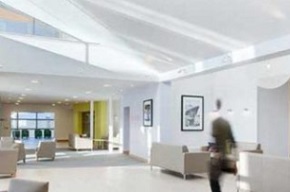Greenbuild 2017
In an environment where ‘partnership is the new leadership,’ the International WELL Building Institute™ (IWBI™) and BRE used Greenbuild in Boston, USA in November 2017 to demonstrate the value of collaboration on multiple levels to advance human health through better buildings.
In November 2016, we reported that the International WELL Building Institute (IWBI) and BRE had announced an alignment between the WELL Building Standard (WELL) and BREEAM. Combining the two standards was intended to make it easier for projects seeking to conform with them.
At Greenbuild, IWBI Chairman and CEO, Rick Fedrizzi said:
"Our relationship with BRE is in evidence across several categories. We’re proud of the pioneering work we’ve done by developing a crosswalk between the WELL Building Standard and BREEAM, simplifying for the market opportunities to use these two leading building standards in tandem to achieve both sustainability and human health goals.
"Additionally, we’ve partnered with BRE to undertake practical performance verification research as we are developing WELL v2. On-site performance verification is a unique hallmark of WELL. When it comes to human health, good intentions and checklists are simply not enough to ensure that a building’s performance is in a position to improve human performance. Our shared commitment to this idea of verified performance is why leadership companies are committing to the high bar that WELL provides."
A key resource used by BRE in undertaking this performance verification research is the room-sized environmental chamber in which known concentrations of volatile organic compounds (VOCs) or other indoor air pollutants may be introduced into the space at controlled temperature, humidity and ventilation rates.
The chamber, built to the standard room specifications prescribed in the European Standard CEN/TS 16516: 2013, was designed, built, and commissioned as part of a recent collaborative European Commission (EC) research project.
Two VOC source chambers are used – one to trial the VOC sources and one through which air is passed to carry the VOCs into the chamber. In the current, research the chamber is used to compare VOC measurement methods and technologies for the determination of ‘TVOC’ (total VOC) in air at given concentrations of selected VOCs.
The current research initiatives being undertaken jointly by BRE and IWBI also involve evaluation of monitors used to measure particulate matter in air, and evaluation of the methods used to measure light levels and to use the data in order to assess circadian lighting.
Dr. Andy Dengel, CChem MRSC, Director, BRE Environment said:
"We see the value of successive rounds of collaborative research in pushing the envelope when it comes to ensuring that performance verification methodologies are robust and fit for purpose. That’s why we’re excited to showcase this work to WELL practitioners and power users who are contributing to the development of WELL v2."
Martin Townsend, Director of Sustainability at BRE said:
"If we are to drive change for the built environment at all the different scales of design and operation, we need to create strong partnerships with like-minded organisations. In doing so, we can create a supportive environment for the industry to improve the way in which we look at buildings. Such certainty comes from the industry having confidence in an independent approach and standards built on research and science, a belief IWBI and BRE share."
This article was originally published here on 16th Nov 2017 by BRE.
[edit] Find out more
[edit] Related articles on Designing Buildings Wiki
Featured articles and news
RTPI leader to become new CIOB Chief Executive Officer
Dr Victoria Hills MRTPI, FICE to take over after Caroline Gumble’s departure.
Social and affordable housing, a long term plan for delivery
The “Delivering a Decade of Renewal for Social and Affordable Housing” strategy sets out future path.
A change to adoptive architecture
Effects of global weather warming on architectural detailing, material choice and human interaction.
The proposed publicly owned and backed subsidiary of Homes England, to facilitate new homes.
How big is the problem and what can we do to mitigate the effects?
Overheating guidance and tools for building designers
A number of cool guides to help with the heat.
The UK's Modern Industrial Strategy: A 10 year plan
Previous consultation criticism, current key elements and general support with some persisting reservations.
Building Safety Regulator reforms
New roles, new staff and a new fast track service pave the way for a single construction regulator.
Architectural Technologist CPDs and Communications
CIAT CPD… and how you can do it!
Cooling centres and cool spaces
Managing extreme heat in cities by directing the public to places for heat stress relief and water sources.
Winter gardens: A brief history and warm variations
Extending the season with glass in different forms and terms.
Restoring Great Yarmouth's Winter Gardens
Transforming one of the least sustainable constructions imaginable.
Construction Skills Mission Board launch sector drive
Newly formed government and industry collaboration set strategy for recruiting an additional 100,000 construction workers a year.
New Architects Code comes into effect in September 2025
ARB Architects Code of Conduct and Practice available with ongoing consultation regarding guidance.
Welsh Skills Body (Medr) launches ambitious plan
The new skills body brings together funding and regulation of tertiary education and research for the devolved nation.
Paul Gandy FCIOB announced as next CIOB President
Former Tilbury Douglas CEO takes helm.
UK Infrastructure: A 10 Year Strategy. In brief with reactions
With the National Infrastructure and Service Transformation Authority (NISTA).
























